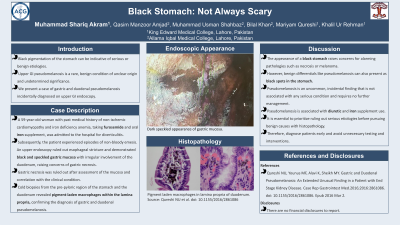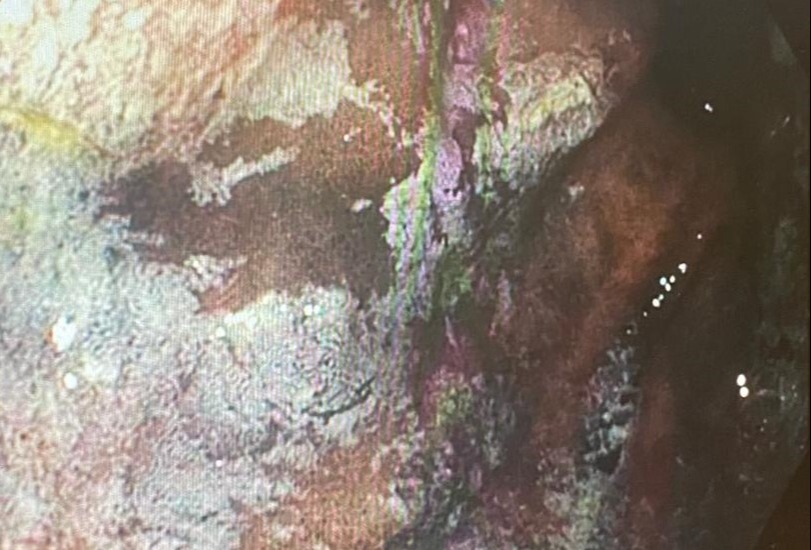Tuesday Poster Session
Category: Stomach
P4196 - Black Stomach: Not Always Scary
Tuesday, October 24, 2023
10:30 AM - 4:00 PM PT
Location: Exhibit Hall

Has Audio

Muhammad Shariq Akram, MBBS
King Edward Medical College
Orlando, FL
Presenting Author(s)
Muhammad Shariq Akram, MBBS1, Qasim Manzoor Amjad, MBBS2, Muhammad Usman Shahbaz, MBBS2, Bilal Khan, MBBS2, Mariyam Qureshi, MBBS1, Khalil Ur Rehman, MBBS1
1King Edward Medical College, Orlando, FL; 2Allama Iqbal Medical College, Orlando, FL
Introduction: Black pigmentation of the stomach can be indicative of serious or benign etiologies. Upper GI pseudomelanosis is a rare, benign condition of unclear origin and undetermined significance. At present, approximately 10 cases of concurrent gastric and duodenal pseudomelanosis have been documented. We present a case of gastric and duodenal pseudomelanosis incidentally diagnosed on upper GI endoscopy.
Case Description/Methods: A 59-year-old female patient with a past medical history of non-ischemic cardiomyopathy and iron deficiency anemia, who was prescribed furosemide and oral iron supplementation, was admitted to the hospital for the purpose of managing diverticulitis. Subsequently, the patient experienced episodes of non-bloody emesis. An upper endoscopy was performed to rule out an esophageal stricture. The endoscopic examination revealed the visual manifestation of black and speckled gastric mucosa with irregular involvement of the duodenum, initially raising concerns regarding the occurrence of gastric necrosis. However, through a comprehensive assessment of the mucosal appearance and meticulous correlation with the patient's clinical condition, the possibility of necrosis was effectively ruled out. To further investigate the underlying pathology, cold biopsies were obtained from the pre-pyloric region of the stomach and the duodenum for subsequent histopathological evaluation. The histopathological findings demonstrated the presence of pigment-laden macrophages within the lamina propria, thereby conclusively confirming the diagnosis of gastric and duodenal pseudomelanosis.
Discussion: The appearance of a black stomach raises concerns for alarming pathologies such as necrosis or melanoma. However, it should be acknowledged that benign differentials like pseudomelanosis can also present as black spots in the stomach. It is essential to prioritize the exclusion of serious etiologies with histopathology. Pseudomelanosis is an uncommon, incidental finding that is not associated with any serious condition and requires no further management. Therefore, it is necessary to diagnose patients early and avoid unnecessary testing and interventions.

Disclosures:
Muhammad Shariq Akram, MBBS1, Qasim Manzoor Amjad, MBBS2, Muhammad Usman Shahbaz, MBBS2, Bilal Khan, MBBS2, Mariyam Qureshi, MBBS1, Khalil Ur Rehman, MBBS1. P4196 - Black Stomach: Not Always Scary, ACG 2023 Annual Scientific Meeting Abstracts. Vancouver, BC, Canada: American College of Gastroenterology.
1King Edward Medical College, Orlando, FL; 2Allama Iqbal Medical College, Orlando, FL
Introduction: Black pigmentation of the stomach can be indicative of serious or benign etiologies. Upper GI pseudomelanosis is a rare, benign condition of unclear origin and undetermined significance. At present, approximately 10 cases of concurrent gastric and duodenal pseudomelanosis have been documented. We present a case of gastric and duodenal pseudomelanosis incidentally diagnosed on upper GI endoscopy.
Case Description/Methods: A 59-year-old female patient with a past medical history of non-ischemic cardiomyopathy and iron deficiency anemia, who was prescribed furosemide and oral iron supplementation, was admitted to the hospital for the purpose of managing diverticulitis. Subsequently, the patient experienced episodes of non-bloody emesis. An upper endoscopy was performed to rule out an esophageal stricture. The endoscopic examination revealed the visual manifestation of black and speckled gastric mucosa with irregular involvement of the duodenum, initially raising concerns regarding the occurrence of gastric necrosis. However, through a comprehensive assessment of the mucosal appearance and meticulous correlation with the patient's clinical condition, the possibility of necrosis was effectively ruled out. To further investigate the underlying pathology, cold biopsies were obtained from the pre-pyloric region of the stomach and the duodenum for subsequent histopathological evaluation. The histopathological findings demonstrated the presence of pigment-laden macrophages within the lamina propria, thereby conclusively confirming the diagnosis of gastric and duodenal pseudomelanosis.
Discussion: The appearance of a black stomach raises concerns for alarming pathologies such as necrosis or melanoma. However, it should be acknowledged that benign differentials like pseudomelanosis can also present as black spots in the stomach. It is essential to prioritize the exclusion of serious etiologies with histopathology. Pseudomelanosis is an uncommon, incidental finding that is not associated with any serious condition and requires no further management. Therefore, it is necessary to diagnose patients early and avoid unnecessary testing and interventions.

Figure: Endoscopy showing gastric pseudomelanosis
Disclosures:
Muhammad Shariq Akram indicated no relevant financial relationships.
Qasim Manzoor Amjad indicated no relevant financial relationships.
Muhammad Usman Shahbaz indicated no relevant financial relationships.
Bilal Khan indicated no relevant financial relationships.
Mariyam Qureshi indicated no relevant financial relationships.
Khalil Ur Rehman indicated no relevant financial relationships.
Muhammad Shariq Akram, MBBS1, Qasim Manzoor Amjad, MBBS2, Muhammad Usman Shahbaz, MBBS2, Bilal Khan, MBBS2, Mariyam Qureshi, MBBS1, Khalil Ur Rehman, MBBS1. P4196 - Black Stomach: Not Always Scary, ACG 2023 Annual Scientific Meeting Abstracts. Vancouver, BC, Canada: American College of Gastroenterology.
